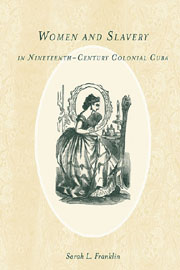Book contents
- Frontmatter
- Contents
- List of Illustrations
- Acknowledgments
- Introduction: Patriarchy, Paternalism, and the Development of the Slave Society
- 1 Virgins and Mothers
- 2 Wives
- 3 Pupils
- 4 The Needy
- 5 Wet Nurses
- Conclusion: A Shifting Landscape
- Abbreviations
- Notes
- Bibliography
- Index
- Rochester Studies in African History and the Diaspora
Conclusion: A Shifting Landscape
Published online by Cambridge University Press: 05 February 2013
- Frontmatter
- Contents
- List of Illustrations
- Acknowledgments
- Introduction: Patriarchy, Paternalism, and the Development of the Slave Society
- 1 Virgins and Mothers
- 2 Wives
- 3 Pupils
- 4 The Needy
- 5 Wet Nurses
- Conclusion: A Shifting Landscape
- Abbreviations
- Notes
- Bibliography
- Index
- Rochester Studies in African History and the Diaspora
Summary
It is the fault of custom, in a great degree, which surrounds women in Cuba with etiquette, iron bars, and formality.
—Samuel Hazard, Cuba with Pen and Pencil, 1871Elites employed patriarchy to impose a rigid ordering on society and to place women and slaves into social positions structured along familial lines. Although they used patriarchy to define social relations, paternalistic notions served to undergird patriarchal control of society by providing the apparatus to maintain the system. As the slave society of nineteenth-century Cuba declined, the system evolved to meet changing needs. Elites would preserve their grip on power, and although over time the model for the maintenance of power would change radically, they worked diligently to uphold the system.
Patriarchy and Free Labor
The advent of free labor in Cuba “meant a fundamental reorganization of labor, landholding, and social relations.” Nineteenth-century Cuba inextricably linked patriarchy and slavery; thus, as the slave society evolved, and Cubans recognized that the institution of slavery might not last forever on their island, the system had to adjust. Patriarchy's ability to shift in the face of changing needs had long been one of its strong suits. The dawning of the Ten Years' War in 1868 would reveal quite clearly the danger inherent in avoiding such a change, yet Cuban recognition that patriarchy would at the very least have to adjust began even earlier.
- Type
- Chapter
- Information
- Women and Slavery in Nineteenth-Century Colonial Cuba , pp. 147 - 158Publisher: Boydell & BrewerPrint publication year: 2012

